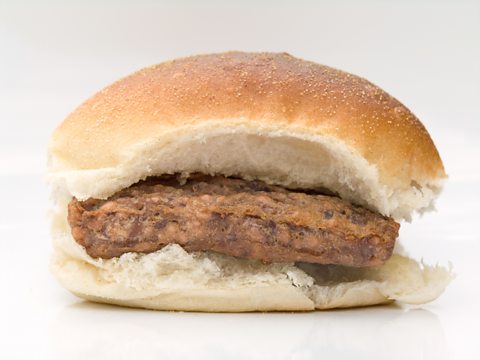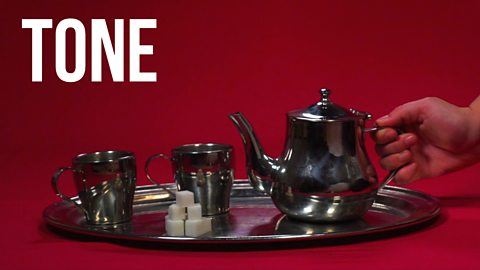In this article you can find out:
- What tone is
- Why we use different tone for different subjects
- How to create tone
This resource is suitable for broadly discursive essay writing for S1, S2 and S3 (Third and Fourth Level Curriculum for Excellence).
What is tone?
Tone is not a technique in itself. When we speak about tone what we mean is the writerâs attitude towards their subject.
Some examples of tone are given below
| Tone | Intended effect |
|---|---|
| Tongue-in-cheek | To poke fun at subject |
| Matter of fact | To convey information in a neutral manner |
| Humorous | To mock subject; to make light of subject; to draw attention to absurdity |
| Emotive | To move reader to sympathy/guilt/anger about subject |
| Angry | To share frustration and anger with the reader |
| Sombre | To explore a sad or very serious event |
| Sarcastic | To ridicule or mock in a harsh manner |
Effective use of tone

A good argument can be strengthened by the effective use of tone. A skilled writer will be able to choose a tone that is appropriate to the subject.
Example
- A persuasive essayAn essay which provides a one-sided argument on a topic. Its aim is to convince the reader to agree with a particular point of view. championing the humble roll and square sausage as the king of breakfasts will use a very different tone, perhaps, to a persuasive essay arguing that people are not taking enough individual responsibility for reducing their carbon footprint.
- The first essay about breakfast food would invite a humorous or light-hearted tone, while the second essay about climate change would invite either a matter of fact or angry tone.
- Both essays have the same purpose (to persuade the reader). However, each essay requires a different tone.

How to create tone
To create tone, a writer could use some of the techniques listed below.
Examples are from an argument against school uniforms.
| Technique | Definition | Example |
|---|---|---|
| Rhetorical question | A question posed to an audience, to which the speaker predicts the answer and gains support from the audience by asking. | Wouldnât you feel happier if you could wear what you wanted to school? |
| Rule of three | Grouping words or ideas in threes makes them memorable and persuasive. | School uniforms are uncomfortable, itchy and worst of all, bland. |
| Emotive language | Language that appeals to the emotions and which will cause the audience to share your point of view, such as anger or joy. | Many students are forced to suffer the indignity of wearing clothes that do not match their personal style for the duration of their school careers. |
| Hyperbole | Using exaggeration for effect in order to draw in the reader. | Millions of school children every year⊠|
| Anecdote | Using real life examples to support your argument. | One girl in a school in Glasgow claims⊠|
| Personal pronouns | Using âweâ, âIâ, âyouâ to make your audience feel included. | We all know how unimaginative school uniforms are⊠|
Challenge
Identify tone
Watch the clip from Newsround below. A tongue-in-cheek tone is used to poke gentle fun at the subject.
Video from ±«Óătv Newsround. Pictures courtesy of Oxana Ware Photography.
NARRATOR Billions of insects called cicadas have been emerging across parts of America after⊠wait for it⊠seventeen years of hibernating underground! So one photographer there has decided to use them to create some unusual artwork.
OXANA I always teach my kids to just be playful and respectful of nature. So that's how the idea was born and we started with my son's fire truck and that was just a huge hit.
NARRATOR Oxana has been snapping them in different and unexpected settings. From playing table tennis to graduating to even getting a vaccine. Well, not the real one of course.
OXANA How many times have you seen cicadas doing archery? This one, I mean, he's a natural. Look at him. Look at him working that bow and arrow.
NARRATOR She collects the insects from her garden.
OXANA There they are.
NARRATOR And then hopes they'll pose for a pic.
OXANA So you see the whole thing is kind of trial and error and since I don't like harming them or making them do anything they don't like to, I just kind of play with them until⊠oh my goodness, okay.
NARRATOR Oxana says most people have been really positive about her cicada snaps.
OXANA I've got a lot of thanks. A lot of kids that were very wary of these things are now not scared of them any more and the clothing line cicada putting on a dress is the reason for that. Kids, like, really enjoyed that
NARRATOR Now that is one creative way to learn to love creepy crawlies!
Can you identify three techniques used by the speaker to create this tone?
In this video, a tongue-in-cheek tone is used to poke gentle fun at the subject.
Here are some examples of how this tone has been created:
- Rule of three: 'from playing table tennis to graduating to even getting a vaccine'
- Informal language: 'pose for a pic'
- Emotive language: 'creepy crawlies'
Next step
When you know how to identify tone, the next step is to think about the tone you want to adopt in your own piece of writing.
Before you start writing, you should be clear about the tone that you want to employ, so that you can select appropriate language features from the beginning of your essay in order to sustain that tone throughout.
More on Discursive, persuasive and informative writing
Find out more by working through a topic
- count6 of 13

- count7 of 13

- count8 of 13

- count9 of 13

